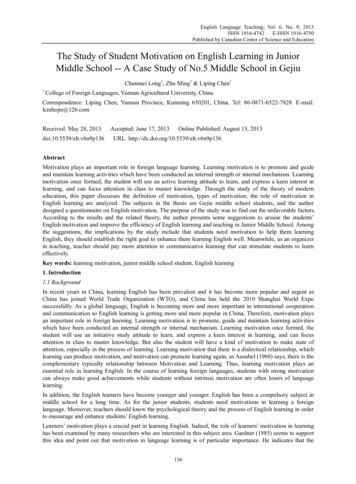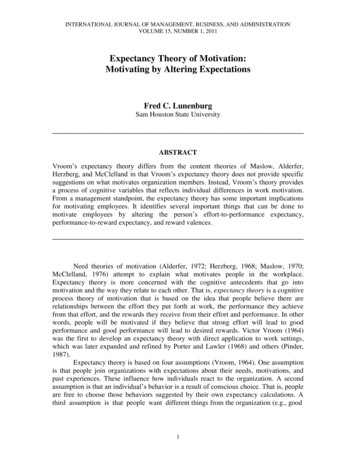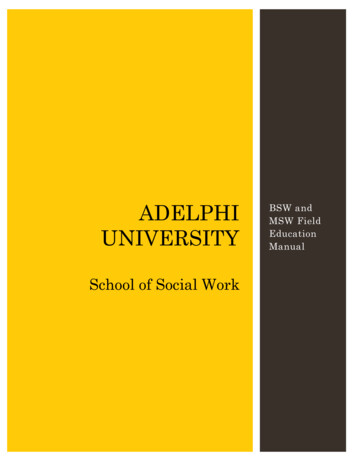
Transcription
Motivation research in the field ofsport and exercise psychologyA bibliometric study of research themes and informationflow between 1985 and 2009Jonas LindahlSociologiska institutionenMagisteruppsats i Biblioteks- och informationsvetenskap, 15 hpHt 2012
AcknowledgementsI would like to thank my advisor, PhD Cristian Colliander, for a thorough and engaging job;PhD Andreas Stenling for the collaboration and a job well done; and Professor Olle Perssonfor some valuable remarks and advices in an early stage of the project.
AbstractObjectives: The objectives of this bibliometric study was to provide an overview of theintellectual structure of motivation research in the field of sport and exercise psychology(SEP), and to show how the intellectual structure of the field has changed over time. Asecondary purpose was to explore the potential of longitudinal citation based science mappingwithin SEP, and further, in the sub-area of motivation research in SEP.Research questions: (1) How did the intellectual structure of motivation research within thefield of SEP evolve between 1985 and 2009 with respect to research themes and topics? (2)How did the flow of information, in terms of citations, between sub areas take shape withinmotivation research in SEP between 1985 and 2009?Data: 739 articles published between 1985 and 2009 were used in this study. Fielddelineation and data collection was conducted with a multi-database approach based oncontrolled vocabulary. The dataset was furthermore expanded by citation-based extension.Methods: A cluster analysis was performed on the retrieved articles based on normalizedbibliographic coupling (i.e., based on shared references topically similar articles was placed inmutually exclusive groups). The cluster analysis resulted in 19 clusters that were classified bya subject expert from the field of SEP. Further, the labeled clusters were visualized asresearch fronts along timelines subdivided into timeslices – 1985-1994; 1995-1999; 20002004; 2005-2009 – showing the growth and decline of research topics within motivationresearch in SEP. Direct citations between the research fronts was extracted and visualized inorder to explore information flow.Results: Some main findings were: (1) timeslice 1985-1994 consisted of a dispersedcollection of research fronts. No dominating research theme or theoretical framework couldbe discerned in this period; (2) the timeslices of 1995-1999 and 2000-2004 was dominated byachievement goals oriented research; (3) during timeslice 2004-2009 self-determinationtheory oriented research underwent a drastic growth. This timeslice was dominated byachievement goals oriented research and self-determination theory oriented research. In thedirect citation network highly influential research fronts (i.e., influential research themes)could be identified. The top five with respect to received direct citations was: (1) Task-egoachievement goals 1; (2) Task-ego achievement goals 2; (3) Self-determination theory 1; (4)Motivational climate; (5) Percieved competence and motivation among children and youth.
Table of contents1. Introduction1.1 Objectives and research questions112. Motivation research in sport and exercise psychology2.1 A brief review of the literature2.2 Definitions1233. Theoretical framework3.1 Bibliometrics and science mapping: definitions, contexts and terminology3.2 Formal scientific communication3.3 Citation analysis, citation databases and motivation research in sport and exercisepsychology: possibilities and limitations3.4 Citation theory3.5 Timeline visualization of research specialties4474. Methods4.1 Basic concepts4.1.1 Field delineation and data collection4.1.2 Bibliographic coupling4.1.3 Cluster analysis4.1.3.1 Determining k clusters4.2 Procedure4.2.1 Retrieving a core set of articles4.2.2 Citation-based extension4.2.3 Identifying research fronts4.2.3.1 Choosing k clusters4.2.4 Visualizing the development of motivation research in sport and exercise psychology4.2.4.1 Timeline visualization I: Publications and research front topics4.2.4.2 Timeline visualization II: Direct citation network16161617192020202629303132345. Results and discussion5.1 Timeline visualization I: Publications and research topics5.1.1 Keyword network: Identifying sub-themes5.2 Timeline visualization II: Direct citation network5.3 The research fronts of motivation research within sport and exercise psychologybetween 1985 and 2009353639406. Conclusions527. Reference list558101447
1. IntroductionIn this quantitative research review, bibliometric methods was used to map the intellectualstructure of motivation research conducted in the field of sport and exercise psychology (SEP)between 1985 and 2009. The time frame of this study – 1985-2009 – was dynamicallysubdivided into one ten-year period, 1985-94, and three five-year periods, 1995-1999, 20002004, 2005-2009, in order to address the longitudinal perspective.In two earlier studies, Lindahl (2011) and Lindahl, Stenling, Lindwall, and Colliander(2012), where different aspects of the intellectual structure of SEP was examined between2008 and 2011, the results showed that motivation research was the largest sub-area withinthe field.1.1 Objectives and research questionsThe objective of this study was to provide an overview of the intellectual structure (i.e.,research themes and topics) of motivation research in SEP, and to show how the intellectualstructure of the sub-field has changed over time. To be more specific, with the longitudinalperspective two aspects of motivation research within SEP was investigated: (1) the growthand decline of identified sub areas, and (2) the flow of information between these sub areas(i.e., influential sub areas in terms of the contribution of useful knowledge, and in which subareas this knowledge is used). For these purposes the following research questions wasarticulated: How did the intellectual structure of motivation research within the field of SEPevolve between 1985 and 2009 with respect to research themes and topics? How did the flow of information, in terms of citations, between sub areas take shapewithin motivation research in SEP between 1985 and 2009?Due to the lack of similar studies regarding methodology and object of analysis, thelongitudinal aspect of motivation research in SEP was in this study viewed as a secondaryexplorative purpose, involving the examination of possibilities and limitations of longitudinalcitation based science mapping studies in the specific sub-area of motivation research in SEPfield of SEP, and furthermore, within the field of SEP.2. Motivation research in sport and exercise psychologyThe object of analysis in this study was motivation research within the field of SEP. Thissection consists of two parts. In the first part a brief review of earlier research reviews1
concerning motivation research in SEP is conducted. In the second part the definitions of thefield of SEP and motivation research within SEP is presented.2.1 A brief review of the literatureDuring the 1970s and 1980s sport and exercise psychology research develops into anacademic sub-discipline within psychology in its own right with the start of a number of corejournals (see Table 2, page 21). The systematic study of motivation in a sport and exercisepsychology context has been pursued since 1970s (Roberts, 1992, p. v). According to Mayer,Faber, and Xu (2007), who reviews the literature on motivation measures between 1930 and2005, motivation measures in the context of SEP starts developing during the 1980s.Even though no former research reviews similar to this study – with respect to aim andmethodology – could be found, some research reviews, and review sections within empiricalarticles and textbooks, relevant for the scope and timeframe of this study could be identified.Most of the former reviews and relevant literature consist of (1) review articles with a broadscope, covering the field of SEP or motivation research within SEP (e.g., Biddle, 1997;Biddle, 1999; Chatzisarantis, Hagger, Biddle, Smith, & Wang, 2003); (2) reviews of specificsub topics within the context of motivation in SEP (e.g., Martin, Moritz, & Hall, 1999;Ntoumanis & Biddle, 1999; Vallerand & Losier, 1999); and (3) textbooks reviewing thedevelopment of research themes associated with, or within the context, of motivation researchin SEP (e.g., Hagger & Chatzisarantis, 2007; Roberts, 1992; Roberts & Treasure, 2012). Themajority of these reviews consist of qualitative content analysis.Some outlines could be identified by studying the review literature concerning thedevelopment of motivation research in SEP. There seem to be an agreement in the literaturethat from the 1970s the cognitive paradigm has been important to the study of motivationwithin the field of SEP. In the context of SEP the cognitive paradigm consists of number oftheories where it is assumed that “behavioral variance in sport and exercise is [ ] capturedby models that incorporate the cognitions and beliefs of individuals; in other words, thecognitions and beliefs of individuals mediate their behavior” (Roberts, 1992, p. 8). Roberts(1992, p. 8-15) outlined the theoretical frameworks of attribution theory; theory of selfefficacy; motivation theories revolving around perceived competence; and achievement goalsapproaches, as the dominating theories and approaches at the time. According to Biddle(1999), achievement goals orientations was “the ‘hot topic’ of sport psychology in the late1990s, [and] attribution theory was certainly the equivalent in the 1980s” (Biddle, 1999, p. 7).Furthermore, Biddle predicts self-determination theory as the leading framework in the future2
(i.e., post 1999). In Roberts and Treasure (2012), the dominating contemporary theories areidentified as organismic (e.g., self-determination theory; hierarchical goal model) and socialcognitive theories (e.g., achievement goal theory; theory of self-efficacy).2.2 DefinitionsIn order find a definition of the field of sport and exercise psychology I consulted a subjectexpert from the field of SEP.1 With respect to the methods used in this study I wanted a broaddefinition of the field and was recommended to use the definition proposed by the Europeanfederation of sport psychology (FEPSAC, 1995):Sport psychology is concerned with the psychological foundations, processes andconsequences of the psychological regulation of sport-related activities of one or severalpersons acting as the subject(s) of the activity. The focus may be on behaviour or on differentpsychological dimensions of human behaviour, i.e. affective, cognitive, motivational orsensori-motor dimensions. The physical activity can take place in competitive, educational,recreational, preventative and rehabilitation settings and includes health-related exercise.Subjects are all persons involved in the different sport and exercise settings, e.g. athletes,coaches, officials, teachers, physiotherapists, parents, spectators etc. (p. 1)The field of SEP is characterized by a high degree of interdisciplinary and applied research.Three main areas can be discerned: (1) sport practice, (2) psychology, and (3) other sportsciences. The relationships between these areas are described in FEPSAC (1995) as follows:1. Sport psychology – Sport practice: Sport psychology is faced with issues that arisefrom exercise and sport practice. It tries to better understand these demands andattempts to give assistance in satisfying them.2. Sport psychology – Psychology: Sport psychology is an applied subdiscipline ofpsychology. It partly draws upon knowledge adopted from different branches ofpsychology and contributes to the further understanding of psychology in general.3. Sport psychology – Other sport sciences: Sport psychology is one discipline of thesport sciences. The more sport psychology generates specific knowledge by empiricalwork in the field of sport and physical activity, the more the findings and methods of1The subject expert is a member of the Sport psychology group at the Institution of psychology at UmeåUniversity.3
other sport sciences have to be accounted for. Some questions may be answered usinginterdisciplinary approaches. (p. 1)Many suggestions have been made concerning a definition of the concept of motivationwithin the discipline of psychology, as well as within the field of SEP (Kleinginna &Kleinginna, 1981). I was looking for a broad definition of motivation research in SEP and byconsulting a subject expert the following definition was formulated:2 Motivation researchwithin SEP refers to a set of problems, topics and themes, theories and methods related to andused in a SEP context, where motivation can be defined as “the investigation of theenergization and direction of behavior” (Roberts, 1992, p. 6).Due to the broad scope of this definition a second criteria was imposed during the datacollection phase: for an article to be validated as motivation research in SEP, motivation hadto be a variable in the conducted study.3. Theoretical frameworkThis section consists of five headings. The first four consist of (1) an introduction tobibliometrics in terms of definitions and terminology; (2) formal scientific communicationand bibiometrics; (3) citation analysis and citation databases; (4) and citation theory. Underheading five the concepts of research specialty and timeline visualization are presented.3.1 Bibliometrics and science mapping: definitions, contexts and terminologyBibliometrics refers to the “quantitative analysis of bibliographic data” (Noyons, 1999, p. 3)and is applied within at least four areas (Noyons, 1999, p. 4-5): (1) Performance analysis,where the performance of scientific research units is evaluated with respect to activity,productivity and impact; (2) Information retrieval, where bibliometric methods is used in theprocess of information seeking; (3) Library management, where bibliometrics is used in thecontext of libraries (e.g., to manage journal collections); and (4) Science mapping, which isconcerned with the analysis and visualization of the structure and development of science: theapplication area to which this study belongs.The variables used in bibliometric analyses is extracted from bibliographic data – metadataassigned to describe and identify publications (Kärki, Kortelainen, Eriksson, & Ungern-2For a contextualization of this definition with respect to the hierarchy of science and a model for formalscientific communication, see section 3.5 Timeline visualization of research specialties.4
Sternberg, 1998, p. 6). Publications, (co-)authors, references and citations are the mostcommon variables used in bibliometric analyses (Glänzel, 2003, p. 12).In bibliometrics references and citations denote two different concepts, their relationshipcan be expressed as follows (Egghe & Rousseau, 1990):If paper R contains a bibliographic note using and describing paper, C, then R contains areference to C and C has a citation from R. Stated otherwise, a reference is theacknowledgement that one document gives to another, while a citation is theacknowledgement that one document receives from another. (p. 204)Thus, references are given by documents and citations are received by documents. Assuggested above a distinction need to be made between bibliometric analyses that are basedon the concept of references and bibliometric analyses based on citations. In reference basedanalyses, the cited references in the reference list of a document are analyzed from the pointof view of the citing document, and in citation based analyses, the received citations areanalyzed from the perspective of the cited document (Kärki et al., 1998, p. 10).In bibliometric analyses a variable is examined in order to gain knowledge of a bibliometricunit, which consists of a population of documents (e.g., books; reports; patents; articles)collected with respect to some criteria (e.g., a specific subject area; a number of journals; anauthor; an institution; a continent) (Glänzel, 2003, p. 12). To exemplify, by counting thenumber publications of a bibliometric unit (e.g., a researcher) during a given period of time, ameasure of productivity, or outcome, is obtained. A measure of influence or impact, on theother hand, is obtained if the variable is changed to citations (i.e., received citations). Thesetypes of measures are called bibliometric indicators.Gauthier (1998, p. 10) subdivides the numerous bibliometric indicators into two maincategories:1. Descriptive indicators2. Relational indicatorsDescriptive indicators are generally used within the application area of performance analysis,where focus lies on research activity, productivity and impact, while relational indicatorsmeasures relationships – in terms of similarity, or association – between bibliometric units ondifferent levels of aggregation (e.g., documents; authors; universities; countries). Relationalindicators are used within the application area of science mapping in order to, first and5
foremost, map the structure of social networks and knowledge domains in science (Morris &Martens, 2008, p. 215). Relational indicators usually measures, either the relationshipbetween bibliometric units, or between tokens (e.g., cited references; words; authors) cooccurring within bibliometric units. In science mapping a number of relational indicators areused. Here I briefly describe three very common citation-based measures in science mapping,of which two – bibliographic coupling and direct citation – were used in this study:1. Direct citation (DC), measures topical similarity by identifying citation links betweendocuments. A DC occurs when one document cites another document (Boyack &Klavans, 2010, p. 2391). DC is not widely used in science mapping, but has the nicequality of showing the actual flow of information within knowledge domains (Persson& Ellegard, 2012, p. 251).2. Bibliographic coupling (BC)3, was introduced by Kessler (1963), and measures topicalsimilarity between documents by counting shared references, the more references twodocuments share, the more similar they are assumed to be with respect to subjectmatter.3. Co-citation, was introduced by Small (1973), and measures association, or similarityas perceived by citers, between cited documents. A co-citation occurs when twodocuments are cited by a third document. Thus, while BC measures similaritiesbetween citing documents, co-citations measures similarities between citeddocuments.The specific citation based relations between documents concerning the three measures ofDC, BC, and co-citation are depicted in Figure 1.3Due to the importance of BC to this study a more detailed presentation (e.g., computational aspects,normalization etc.) of the concept is provided in section 4.1.2 Bibliographic coupling.6
CABDFigure 1. Show citation relations where B cites A DC; A and B cites C BC; and Aand B are both cited by D co-citation (modified from Persson (2010)).3.2 Formal scientific communicationA basic assumption in bibliometrics is that the published literature mirrors the researchactivities. Therefore, by the analysis of the published literature (i.e., the formal scientificcommunication (FSC)), a view of science can be obtained (Kärki et al., 1998, p 1). Further, aprerequisite for this assumption, as pointed out by Lundberg (2006, p. 10), is that most of therelevant research is published and made available to the scientific community. FSC can bedefined as communication between science producing units occurring trough the officialchannels of the scientific community (e.g., peer reviewed articles, monographs, chapters inbooks). The most influential model of FSC – according to Cronin (1984, p. 11) – is thescientific journal in which peer reviewed articles are published. The scientific journal fulfillsat least 4 important functions within the scientific community (Cronin, 1984, p. 11):1. It’s a medium that enables the communication between researchers.2. The system of peer review guaranties the quality of the publications.3. The journal works as a channel for the researcher to demonstrate the originalityand value of his/hers research.4. It provides a medium and a system by which acknowledgements can bedistributed between researchers in terms of citations.However, even though the scientific journal and the peer review article is the main channelfor FSC in many scientific disciplines, the channels for FSC and publication praxis tend todiffer between different disciplines and fields. To exemplify, within the humanitiesmonographs are suggested as the most important publication channel (Hammarfelt, 2012, p.7
28-30), and in some technical fields, conference proceedings are very important in terms oftheir FSC (Butler, 2008; Glänzel, Schlemmer, Schubert, & Thijs, 2006). Due to the differentpublication practices within science, and limitations – in terms of coverage of certainpublication formats (e.g., books) – in the databases used to collect the data for bibliometricanalyses, a first step in bibliometric science mapping is to determine the appropriateness ofusing bibliometric methods to examine the FSC of a certain discipline or field (Kärki et al.,1998, p. 41).3.3 Citation analysis, citation databases and motivation research in sport and exercisepsychology: possibilities and limitationsA central principle and practice in science is that new research builds upon older research, andthat the newer research denotes its sources by referencing them. In bibliometrics it is assumedthat indications of the structure and developments of science, as well as indications of quality,influence and impact, can be obtained by analyzing the distribution of citations betweenscientific publications on different levels of aggregation. Such studies falls under the umbrellaterm, citation analysis (Kärki et al., 1998, p. 11). In the context of science mapping, citationanalysis is used to investigate relationships between bibliometric units (e.g., publications,authors, journals) on the basis of citations and references (e.g., by applying co-citationanalysis or BC). The data is usually collected from “bibliographical citation databases whereresearch articles are indexed and made accessible as bibliographic records” (Jarneving, 2005,p. 21), and in addition to the usual meta data, these bibliographic records also contain thereference list of the indexed document so that citation links between documents can beidentified and extracted.In order to determine the appropriateness of the application of analyses within theframework of citation based science mapping in a particular field, two questions arises: (1)how are the publication practices within the field under study? And (2) are there anybibliographic citation databases that appropriately cover the FSC of the field?In this study I used an article set collected from the citation indices of Thomson scientificthrough Web of science (WoS). WoS was chosen (1) due to the longitudinal perspective ofthis study, it was the only identified bibliographic citation database with bibliographic recordscontaining cited references as far back as needed, and (2) due to the interdisciplinary characterof the citation indices of WoS, which was a requirement in this study due to theinterdisciplinary character of motivation research in SEP. WoS covers the FSC of the hardsciences very well (e.g., physics; chemistry; molecular biology), where the FSC model of the8
scientific journal with the peer reviewed article is the dominating one, but does not cover theFSC of the humanities and social sciences (to which psychology belongs) to the same extent.Thus, bibliometric analyses based on data from WoS works best within research fields from,or similar to, the hard sciences in terms of publication practices. However, publicationpractices differ between disciplines and areas within the social sciences. In Hicks (2004, p. 2)it is shown that the FSC of the discipline of psychology are quite similar to the FSC of thehard sciences, and further concluded that bibliometric studies based on WoS in the disciplineof psychology works reasonable well. A similar conclusion is found in Moed (2005) wherethe coverage of a number of fields in WoS are analyzed: “Psychology [ ] are more similar toscience fields, and show good, yet not excellent [WoS] coverage” (Moed, 2005, p. 148). Afurther indication of the appropriateness of performing bibliometric analyses within thediscipline of psychology are the numerous bibliometric studies – based on WoS data, as wellas other databases – that have been conducted on different levels within the framework of thediscipline (e.g., Garcia-Martinez, Guerrero-Bote, & de Moya-Anegon, 2012; o-Blasco,&Buela-Casal,2010).Nevertheless, due to the fact that publication practices differ within disciplines, definiteconclusions of the publication practices in SEP can not necessarily be drawn from studies ofthe publication practice of psychology on the discipline level. SEP is a relatively unexploredsub-field in psychology in terms of bibliometric science mapping. Although citation basedanalyses have been conducted within other sub-areas within SEP (e.g., Bruner, Erickson,Wilson, & Cote, 2010; Bruner, Erickson, McFadden, & Côté, 2009), no bibliometric studiesof the sub-area of motivation reaserch within SEP could be identified.In Lindahl (2011), and Lindahl et al. (2012) citation based analyses based on WoS data wasused to map the intellectual structure of the field of SEP between 2008 and 2011. The resultswere validated by subject experts that could confirm that the analyses and maps provided arepresentative overview of the field. The results from these two studies indicated that the fieldof SEP can be appropriately covered by WoS data, as well as the sub-area of motivationresearch, at least between 2008 and 2011. The possibilities and limitations concerning alongitudinal study of motivation research in SEP based on WoS data could not be predetermined, and has been viewed as a secondary exploratory purpose of this study: Toexamine the possibilities and limitations of longitudinal citation based science mappingstudies within the field of SEP, and further, in the specific case of motivation research in SEP.Another limitation of this study is that it first and foremost, is based on English-languagearticles. Thus, this study covers the internationally oriented motivation research in SEP.9
3.4 Citation theoryAccording to Moed (2005, p. 209) it is important that bibliometric indicators has a soundtheoretical foundation and are empirically tested and validated. In this section citation theoryis briefly presented, along with the theoretical underpinnings of this study regarding theinterpretation of BC and DC.Citation theory tries to answer questions concerning the interpretation of references andcitations in bibliometric analyses: what do citation-based indicators measure, and how canthey – to exemplify – be related to concepts such as intellectual/cognitive influence, or topicalsimilarity between documents?Within the framework of citation theory a number of theoretical positions can be foundspanning over a wide variety of disciplines (e.g., physics, sociology, psychology, history).Moed (2005) subdivides the numerous theoretical positions into two main categories: (1) asocial constructive point of view, and (2) a citation-analytical point of view. According toMoed (2005):A social constructive view of referencing behavior analyses the social conditions andinteractions involved in the publication process. It does not negate that a cited paper has areality of its own, or an identity that also exists outside the world of the citing author, but itsprimary interest lies in analyzing how it may be influenced by the social environment inwhich it is produced. (p. 213)And:A citation-analytical perspective assumes that – under certain conditions – citation analysismay provide valid indications of the significance of a document. Such indications may bedenoted as objective in the sense that they reflect properties of the cited document itself, andthat they are replicable, and based on the practices and perceptions of large numbers of(citing) scientists rather than on those of a single individual scientist. (p. 213)The citation-analytical perspective is the dominating perspective within bibliometrics, and isusually – to a larger or smaller extent – founded in the sociologist Merton’s theory of scienceas a normative and reward based system, where citations are interpreted as acknowledgementsgiven in order to pay intellectual debts and to give recognition to peers for significantcontributions to the development of science. With Merton’s “normative” view, the degree of10
received citations of a bibliometric unit can be interpreted as an indication of intellectualinfluence of that unit within an area of research (Moed, 2005, p. 200-201). The socialconstructive view corresponds to (1) the so called rhetorical system4 of science and can beunderstood as a critique of the citation-analytical view. An extreme position within therethorical system is found in Latour’s theory of citations where it is assumed that researchersprimarily give references for rhetorical purposes (i.e., in defense of attacks, to promote anargument, convince others and to advance the career of the researcher) (Lundberg, 2006, p.11). The social constructive view also corresponds to (2) the so called communication system5of science, which refers to limitations imposed on the referencing behavior, as well as thepotential of receiving citations, based on factors such as communication and information flow(e.g., language, access, size of audience, degree of specialization, etc) (Kärki et al., 1998, p.42; Moed, 2005, p. 215).While the social constructive perspective tend to focus upon particularities in referencebehavior, the citation-analytic persp
During the 1970s and 1980s sport and exercise psychology research develops into an academic sub-discipline within psychology in its own right with the start of a number of core journals (see Table 2, page 21). The systematic study of motivation in a sport and exercise psychology co










